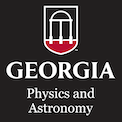Events Calendar View
-
Departmental Colloquium
Oct 23, 2014
Defining Chaos from First Principles

Guest: M. Howard Lee, UGA Physics and Astronomy
Thursday, October 23, 2014 3:30 pm - 4:30 pm
Location: Physics Auditorium (202) -
Departmental Colloquium
Nov 5, 2014
LSST and Dark Energy
I will discuss the current understanding of dark energy and dark matter. Current and future astrophysical surveys should shed light on the amazing fact that the expansion of our Universe has accelerated in recent time. The upcoming Large Synoptic Survey Telescope should provide the most comprehensive dataset available to help answer the question about the nature of dark energy.
-
Departmental Colloquium
Nov 13, 2014
Conquering NMR sensitivity Limitations: DNP Enhanced studies of Cellular Metabolism
Nuclear Magnetic Resonance (NMR) has found applications in fields running from physics, to chemistry, to structural biology and medicine. In all cases sensitivity has been a limitation, requiringmilligramquantitiesofsampleorexceedinglongsignalaveragingperiods. The latter can be particularly limiting for real-time metabolism studies where transit between substrate and product can occur on a time-scale of tens of seconds. Recently Dynamic Nuclear Polarization (DNP) has reemerged as a means of improving NMR sensitivity by many orders of magnitude. DNP enhanced in vivo monitoring of metabolism for cancer diagnosis is near the point of clinical application. Emphasis has been on the conversion one substrate (pyruvate) to a product (lactate). However, the potential for developing substrates that probe other metabolic pathways and elucidate mechanisms of participating enzymesisenormous. This presentation will cover some of the basic physics underlying DNP and illustrate applications with results from enzyme mechanism and in-cell studies on-going at UGA.
-
Special Colloquium
Nov 19, 2014
Bubble Driven Catalytic Micromotors
This year (2014) we celebrate a decade anniversary of catalytic micromotors, in which they have come to represent one of the important technical advances, having shown promise in many important functions in biomedical and engineering fields such as sensing, detection, drug delivery, oil spill cleanup, etc. Catalytic nano-/ micromotors are structures that convert chemical energy present in the surrounding aqueous environment into mechanical work through a catalytic reaction induced by an asymmetrically placed catalyst. In this talk, we will look into different driving mechanisms of micromotors. The focus will be on bubble propulsion and it’s fundamentals.
The bubble propulsion mechanism is observed when the bubbles formed on the catalyst surface eject or burst. The motion of bubbles provides an opposing thrust to the motor. We have studied the motion of bubble propelled big Janus motors using a fast CCD camera. The formation of bubbles depends closely on the nucleation energy, which also is related to surface curvature. It is predicted that bubbles are easier to nucleate on a concave shaped surface than on a convex shaped surface. Thus, bubble propulsion can be easily seen in concave motors. The predictions were confirmed with nanoshell catalytic motors with catalyst coated inside the shell. Similarly, if the catalyst is coated in the inner surface of a tube, a tubular motor can be produced. We used graphene oxide nanosheets (GO) as templates and the stress effect in the multilayer of metal thin films to create microtubes.
Finally, collective motion with micromotors has emerged as an important concept. Collevtive behavior is observed through out the nature and can be emulated in the micromotor world. Using different properties of motional behaviors of motors, motors can be designed to perform tasks collectively. This can ultimately help in increasing the efficiency of completing tasks. We observe a unique collective bubbling with 5-μm diameter Janus motors. The bubbling has always been observed with individual motors, however, for the first time we observe bubble production through a collective effort.
-
Departmental Colloquium
Nov 20, 2014
Exoplanets Exposed: The current revolution in directly imaging exoplanetary systems
There are now several thousand planets known outside of our solar system, but most have been discovered by indirect means. Directly imaging exoplanets is an enormous challenge, sometimes compared to detecting a firefly next to a lighthouse. The last time a newplanet had been discovered through astronomical imaging was our own Neptune in 1846. Within the last ten years, however, advances in space and ground-based instrumentation have provided a handful of new exoplanets discovered by direct imaging. Here I will review the techniques that are used and the Hubble Space Telescope discovery of an exotic planet called Fomalhaut b. Among the directly imaged exoplanets,Fomalhaut b has unexpected characteristics, such as a relatively blue spectrum and a highly eccentric orbit, leading to hypotheses that it is a gravitationally scattered, low-mass planet hosting a giant planetary dust ring or cloud seen in reflected light. Also in 2013-2014, the Gemini Planet Imager (GPI) was successfully commissioned. I will review our accomplishments with GPI so far and discuss our research plan that over the next three years will provide an atlas of 25-50 new exoplanets orbiting nearby stars.
-
Departmental Colloquium
Dec 4, 2014
Are the Parameters of the Standard Model fine-tuned for Carbon-based Life?
I discuss some recent results obtained using ab initio lattice simulations of effective field theory to probe nuclear structure. I present recent lattice calculations of the Hoyle state of 12C and whether or not light quark masses must be fine-tuned for the viability of carbon-based life.
Page 58 of 121, showing 6 records out of 723 total, starting on record 343, ending on 348

